by Tom Gaylord
Writing as B.B. Pelletier
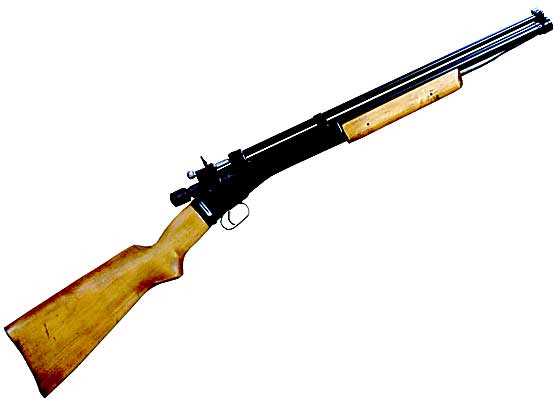
Crosman’s 100 is a .177 caliber variation of the more plentiful model 101.
This report covers:
- Texas Airgun Show
- Model 100
- Refinished and resealed
- Description
- Bolt action
- Sights
- Reference material
- What’s next?
Today we begin looking at a variation of a multi-pump pneumatic rifle we have seen before. And when I say we’ve seen it, we have never seen this particular variation. What we have looked at its sibling, the .22-caliber Crosman 101. Both rifles got their start with the Crosman model of 1924, which was a .22-caliber multi-pump that came to market in — you guessed it — 1924!
The model 100 is simply the .177 caliber variation of the 101. It is scarce because during the time when it was manufactured, .177 was not a popular caliber in the United States. The larger .22 sold many times as many guns — probably for all the reasons you have discussed on this blog.
Texas Airgun Show
I first saw this rifle on the table behind me at this year’s Texas Airgun Show. I was more interested in the Crosman 102 repeating multi-pump sitting next to it, but once I read the tag and discovered this was a model 100, my interest spiked.
Long story short, neither gun sold at the show, so I bought them both. The 102 had a leaking issue, so I waited until the owner could fix it. I am starting with the model 100 first, because reader RidgeRunner expressed an interest in the model. Like most airgunners who have been to at least one airgun show, he has seen lots of 101s and he knows how scarce the 100 is.
Model 100
While the model 101 .22 caliber rifle started production in 1925, it wasn’t until 1940 that Crosman added the .177 caliber model 100 rifle to the line. Throughout the years of this rifle’s run (1940-1950), the Crosman Corporation didn’t appear overly fond of the .177 caliber. They offered their airguns in that caliber to satisfy a growing demand that may have been created when military personnel returned from World War II. They had seen the small .177 or 4.5mm caliber in Europe and decided that was what they wanted. But American airgunners who hadn’t been to war would still be wed to the .22 for another 15 years.
Production of the 100 ended in 1950. It’s impossible to know for certain how many were made but I have seen about 100 Crosman 101s for every 100 I’ve seen. Since they are identical except for the caliber there may have been some that escaped my notice, but they are scarce!
This is not my first 100. Years ago when I was still living in Maryland and writing The Airgun Letter I had one. I remember it shooting faster than the .22 but that’s about all I can recall. At some point I sold it or traded it for something else. Oddly, though, I did keep the model 101 from those days, which is the same rifle I used for the report I linked to, above.
Refinished and resealed
This rifle was resealed and refinished by the former owner, Jeff Cloud. You may recall that he also resealed my Sheridan Blue Streak last year. That job turned out beautifully, so I knew this one would be good. Jeff also refinished the rifle. The Crosman 100/101 series rifles are very popular with refinishers because they are so simple and straightforward to work on. The metal was originally painted at the factory, so you are doing nothing wrong when you sand and repaint it.
The wood can be any variety of hardwood, from walnut, though maple, beech and gum. I think this one is either beech or gum. There are several different stock profiles — high comb, low comb, etc. — that Crosman collectors obsess over. There are even some factory stocks with a checkered pistol grip.
Rifles made during the 1940s often have hard rubber pump handles with a soft rubber bumper inside to keep them from clicking against the pump tube when the handle is closed. These models were sold as “clickless” guns, the idea being they didn’t make noise when they were pumped. But if the rifle is in good tune the handle doesn’t have to click even without the bumper. This one doesn’t.
Both the 101 and the 100 were called the Silent model from around the 1930s to the end of their run. That referred to the quiet discharge sound, compared to a .22 rimfire. Crosman also used the slogan “Power Without Powder” for much of the production run. The model number crept in much later, probably to help keep the parts organized (the parts peculiar to a specific model often have the model number incorporated into the part number).
Description
This is a single shot bolt action multi-pump pneumatic air rifle. My example weighs exactly 5-1/2 pounds. Overall length is 35 inches with a 20-inch barrel, so this is a smaller air rifle. Length of pull on my rifle is 13-1/5 inches, so it feels comfortable, but a little small.
The rifle is all metal and wood, except for the rubber pump handles found on some rifles, as noted above. The metal is steel in many cases and cast aluminum in other cases like the receiver. The model 100s almost all have bronze barrels that were rifled by Crosman. They started rifling their own barrels around 1948 and bronze was far easier to rifle than steel. It also resists corrosion from the rapidly decompressing air when the gun fires. A few steel barrels are encountered on rifles of the late 1940s, but the norm is bronze. Bronze barrels are always painted; steel barrels are blued.
In the beginning Crosman set a maximum pump limit of 6 pumps and they didn’t specify a minimum. As time passed their literature began to say that more than 6 pumps were okay if you really needed the power, but six were still the recommended maximum. I typically stop at 8 stokes when I’m going for power — the upper limit set by Sheridan.
You must cock the gun before starting to pump. If you don’t, all the air will be exhausted on each pump stroke, because the heavy spring-loaded striker presses against the firing valve, holding it open when the gun is at rest. That raises the question of how you leave the gun stored with a pump of air inside — which has been recommended by Crosman since the 1920s! The answer is to pump in one or two pumps (I put in two), then hold the cocking knob and pull the trigger. You can lower the striker slowly this way and the gun will remain sealed, but most owners do one additional thing. They unscrew the cocking knob until all tension is off the firing valve, ensuring the gun will remain sealed. A gun that’s properly sealed will hold air for many months this way.
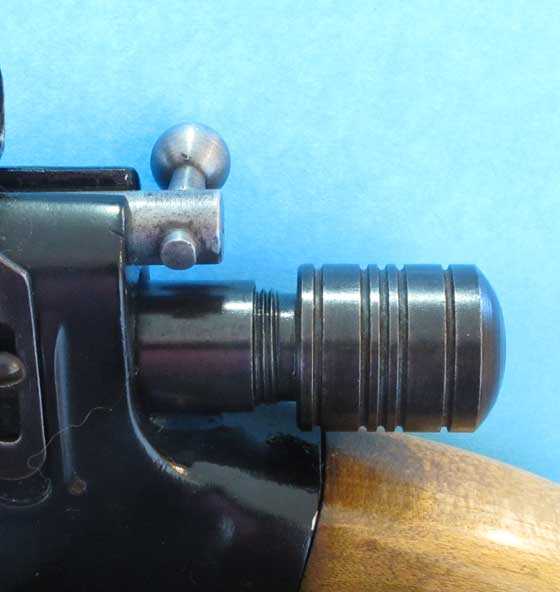
When the rifle is stored it gets two pumps of air and the cocking knob is unscrewed.
Bolt action
The rifle has a turnbolt, but it doesn’t cock the striker. It’s simply there for loading and for sealing the breech. There are no seals or o-rings on this bolt. The breech is sealed by the fit of the bolt face against the rear of the breech. A half pin on the side of the bolt engages the receiver when the bolt is closed, pushing the bolt forward to make this seal airtight.
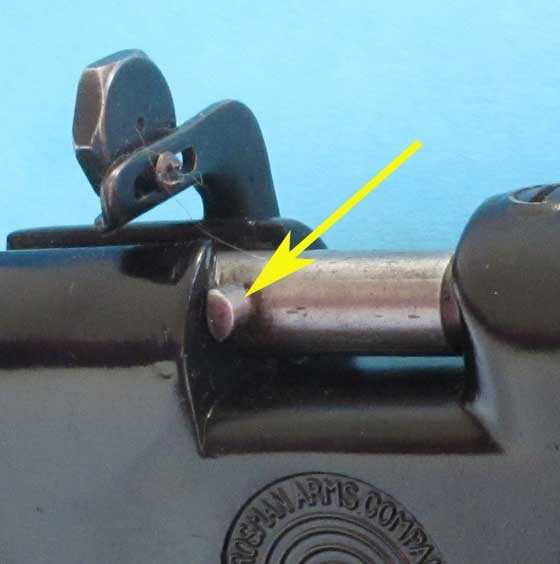
That half pin (arrow) pushes against the face of the receiver which pushes the bolt face forward to seal the breech.
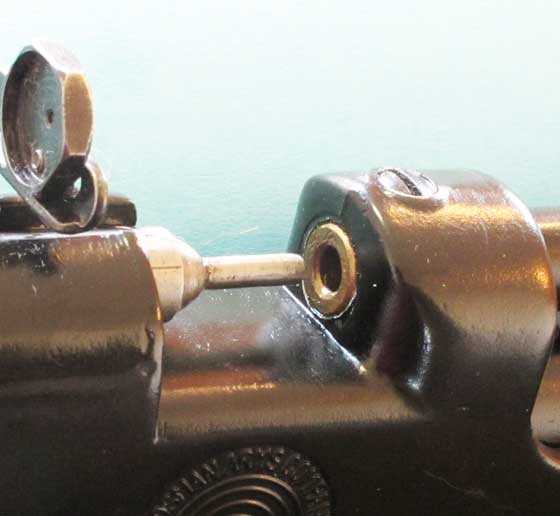
The pin pushes the tapered face of the bolt into the bevel at the breech of the barrel, sealing it perfectly.
Sights
The sights on the 100 and 101 are one of the things that delight shooters. They are a squared-off post in front and an adjustable peep in the rear. The peep adjusts up and down and side to side on slots. Both adjustments use locking screws to hold the sight in place. You lose the precision of positive click detents but save the considerable expense and complexity of their design.
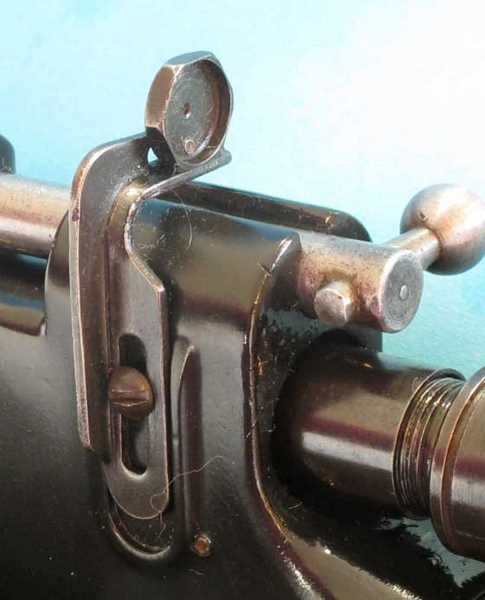
Here you see the details of how the rear sight adjusts.
Reference material
I used the Blue Book of Airguns to research this report, but I didn’t stop there. Many years ago Dean Fletcher (D.T. Fletcher) published a series of books about Crosman and Benjamin airguns. I used two of them, The Crosman Rifle 1923-1950 and 75 Years of Crosman Airguns to discover some little-known facts, like the 6-pump recommendation and always storing the gun with compressed air.
What’s next?
I will treat this report like any other, with velocity coming next, followed by accuracy. If you have anything else you would like to know about, now is the time to tell me. And, don’t forget, there is a 102 repeater coming, also!

B.B.
This is going to be an interesting way to compare the performance of .22 vs .177. Probably not in accuracy but in power derived from a pumper.
Siraniko
PS: Section Model 100 Last sentence, “But American airgunners…” seems like you were half finished with a thought then something interrupted you.
Siraniko,
Thanks. Fortunately I could still remember the thought.
Fixed,
B.B.
BB
I think I’m noticing something. Can’t recall all. But seems like you trade or buy from people you know most of the time. Of course. Correct me if I’m wrong.
GF1,
I think it’s more a case of people get to know me at the shows. I bought several airguns from Carel in the Netherlands, whom I have never met.
B.B.
BB,
It turns out that mine is the 101 in .22 caliber. I have not had time to tear into mine yet, but it is sitting on the table in the loft waiting for me.
Mine appears to be the same version as yours with one small exception. Instead of a peep sight, mine has a notch. I strongly suspect it is homemade, most especially since it is so deep and large. Also the placement is too close to the eye for best results, although if it was a proper size notch it might work well. No matter, during the rebuild it will be replaced with a peep.
RR,
I knew you had the 101. And yes, the large notch is a home job. The 100-series always had the peep.
B.B.
BB,
Does your 100 have a bronze barrel? My 101 has a steel barrel.
RR,
Yes, it’s bronze. Crosman bought steel barrels from Remington before they started rifling their own, so that’s where your barrel came from — probably.
B.B.
BB
You mention corrosion from rapid decompression of air when firing. While this makes sense I don’t recall it being ever mentioned in this blog in the few years I have been reading here. Most air gun barrels are steel now increasing the chance of corrosion. Is this a problem to merit concern? I’m guessing it isn’t but don’t all types of air guns decompress air when firing except CO2?
Decksniper
Decksniper,
Good question. The answer depends on the powerplant. Spring-piston airguns do compress air, but the volume is so small that this doesn’t apply. Also, the air is heated rapidly to very high levels, which helps offset any potential problem.
Single strokes compress and store air for a short period before the shot, but again the volume of compressed air is too small to matter.
Multi-pumps and precharged guns use a very high volume of air compressed to a lower pressure. It doesn’t pop out of the valve — it flows out. This air is still compressed, so when it decompresses it does condense a lot. In these types of airguns a non-ferrous metal barrel is an advantage. Is it necessary? No. But it doesn’t hurt to have it, either. And, it is a selling feature.
B.B.
I have had a 100 for years. It is one of the most accurate guns I have. It’s one than I will not ever part with.
Bobbyjim,
Welcome to the blog.
It’s great to hear from an owner of this rifle. As my report progresses I hope to hear more from you about your rifle.
B.B.
B.B.,
You got my attention when I saw “100.”
I commend you on the photography. The detail is excellent. I am no machinist, but your detailed pics of the bolt and probe in particular give me the impression these were exceptionally well made. Today very few mass produced products, or should I say products produced for the masses, are as well done as this. Everything looks industrial or military grade to me.
Michael
Michael,
Well, this was made during a time when wages were not the major consideration in a product’s price. By today’s standards it looks well-built. Back then it was just business as usual.
B.B.
Michael,
The quality is why I bought my 101. I wanted a multi-pump for RidgeRunner’s Home For Wayward Airguns. The newer multi-pumps are not built with this quality. If you are in the market for a multi-pump and are not afraid you may have to rebuild it, this is the one to have.
RR,
I’ve been considering a 102 for a long time. The 100s are too rare. Overall, however, I’m a Sheridan guy, having had relatives who worked there up in Racine. Still, this series of reports plus a reread of B.B. Pelletier’s reports on the 102 might light a fire under me.
I consider multi-pumps at low power to be underrated plinkers.
Michael
Michael,
I am hoping that my 101 will do a great job on the feral soda cans around here.
B.B.,
This is just one more blog that shows me how little I know about airguns and their history. Much of that history shows variations on a theme, but there are many interesting variations (and these are the ones that made it to market or at least have some prototypes that haven’t been destroyed or locked in some vault).
I was fortunate enough to shoot a Hatsan BullBoss .22 caliber last Saturday. I sent five rounds into a 1 inch spread at 39 yards (distance determined by a laser range finder and we were too lazy to move anything). This is very similar to my experience with the Hatsan Carnivore PCP and the Daystate. It seems that Jerry’s setup for himself works rather well for me, also. With my own little break barrel, I shot the same target at 39 yards and managed a 2 inch spread which is not bad (my Titan would expand the spread to more like 3 inches at 39 yards).
Oh, BTW, the BullBoss is a side lever gun; Hatsan positions the lever forward of the pellet clip whereas some others position the lever behind the clip. The forward position is definitely nicer.
I don’t know if I mentioned it, but setting the clock back an hour has severely crimped my after work shooting sessions. However, I have taken to mounting an LED tactical light atop the scope and I can definitely get used to this. I am shooting with white light, but I have infrared LED to swap out. Pyramydair sells a number of similar products, but not the one I purchased. Mine is the economy package and the case is a nice cardboard. However, I was envious of the plastic protective water proof cases. Then I received a Harbor Freight circular that include a coupon for a case that fit the bill. Ten buck plus tax and I transferred the cushioning to my new case and I love it. Harbor Freight may be my new Sears Christmas wish list.
~ken
Nice 100!! Looking forward to the rest of this series – I always wondered how fast my 101 would shoot if it was fitted with a .177 barrel 🙂
Still plan on refurbishing my 101 this winter.
Happy Monday all!
Hank
Hank,
It looks like both of us will be rebuilding a 101 this Winter. Send me photos as you go and I will reciprocate.
RR,
Sounds like a plan 🙂
Hank
One thing I’ve had against multi-pumps despite their various strengths is having to work the pump several times and then work the bolt for each shot. That is better than having to work a long lever and a bolt like the Daisy single-pumps, but that’s the best I can say.
Decksniper, I think that B.B. gave us a coded answer to the German naming conventions with the name of the Crosman 1924. As I recall, the MG 34 was invented in 1934 and all the other model names correspond to their years of invention. But that doesn’t apply, as you pointed out, to the American names. I believe that even the current service tank is called M1, just like the Garand, the carbine, and the WWII helmet.
mildot52, thanks for explaining the mystery of the MAS 49. I could not understand how a direct gas system that has been associated with unreliability could be in a gun that some claim to be superior to the Garand. So, the key is having the gases push on a rear lug and not enter the action. Sounds like a great idea. You would think that all the people fitting pistons to ARs could try this. As for the torture tests of ARs, I’ve seen many which are impressive. As usual I have no direct experience here, but I did read the analysis behind the redesign of the M4 into the HK416 that was driven, among other people, by the special forces veteran, Larry Vickers. The report identified three problems with the AR that they set out to fix. The first was the DGI system which was replaced with a piston. The second was that they claimed there was something wrong with the magazine. I don’t know what exactly, but I do know that one of the strong points of the Mauser 98 design is its feeding, so if it’s possible to do that well, it’s possible to do it badly. I don’t remember the third problem, perhaps it was the trigger. Not only do AR factory triggers not perform well, but in torture tests that I’ve seen, they are one of the first parts that seem to malfunction.
I had my range session on Saturday with my Garand and my reenactment gear, and the paratroops took some heavy casualties. I touched off the first round and what should I see over the barrel but the case head of the next round sticking up out of the action where it was jammed! There were some more jams one of which was stuck so hard in the chamber that I had to hit the charging handle with a mallet to get it out. This caused the cartridge to come apart, dumping powder and the bullet down into the magazine. There was sporadic jamming through the rest of my session. As the blog would say, the bluebird of happiness has slapped me in the face–followed by a boot to the belly and a chop to the kids.
What went wrong? Reflecting on this, I noted that a large proportion of the jams happened when I inserted partially loaded clips, so perhaps I have stumbled on a second Achilles heel of the Garand. The first is its op rod. The second would be topping off the magazine. I never took this seriously because I routinely load single rounds into the magazine. But perhaps inserting a partially loaded clip is different. I figured that the magazine follower would press the rounds into the right position, but maybe not. Even for a rifle as reliable as the Lee-Enfield, it’s said that you shouldn’t load it either with single rounds into the breech or by loading the magazine and then inserting it into the rifle. It’s meant to be loaded with charger clips with the magazine seated. So, the message is not to load partial clips into the Garand or to chamber deformed rounds to reseat bullets that have been pushed out of position. Otherwise, it is possible that the hardy paratroops have stumbled on a new problem of “transitional jamming.” The remainder of my jams came when switching between loads. I recall that when the Marauder came out the blog made clear that the power adjustment is not the same as either the Air Force guns or the S410 which can change the power with a flick of a dial. The Marauder adjustment was intended more like tuning a musical instrument and was meant to to work for an extended time. Possibly my gas adjustment works the same way and was not meant to switch between loads as I have been doing in each session. My gunsmith also told me that one should disassemble a gun as little as possible so as not to disturb the harmony between parts. Maybe a change to the gas system has the same effect, at least in a gun as tightly fitted as mine. Anyway, the paratroops are already plotting a return in the New Year.
Meanwhile, I have other things to worry about. My boss just dropped off her knives to sharpen. I performed the basic pre-test by seeing if they would stick on a pen held at 45 degrees and they all did! Yeow! She has a high standard for knives, and I am in trouble. Thankfully, they don’t quite shave hair off the arm, but maybe I should look into express mail with Grandmaster FrankB.
Matt61
B.B.,
Sometimes I have loose associations and flight of ideas. Looking at your blog about the action target I had images of targets where when you hit the mark a clown head pops up and laughs “his head off” then plops back out of sight. Of course, this requires something more, probably battery operated. It may not be practical, but it seemed like a good idea for a moment. I am sure all of us can think of other outrageous target ideas.
~ken
BB,
Did you ever give the effort required for each pump of your Sharp target rifle? It would interesting to compare it to the Crosman 100, especially concerning velocity.
Brent
Brent,
The Sharp would win, hands down.
B.B.
Did you measure the pumping effort for each pump of the Sharp?
Brent,
No. I said that because I know the Sharp is more powerful.
B.B.
This comment was sent to blogger. I do not answer questions addressed there, but this is a good one that I am posting and answering here.
B.B.,
I’m a 68 years young guy from Arizona and bought a .177 Gamo Whisper Fusion Pro from you guys a few years ago thinking I could use it to keep the coyotes away from my dogs on our rural property. Two things happened though. First, I could never find a pellet to shoot good enough to even make me want to shoot at anything alive. And second, Arizona Game & Fish either changed the law or I just discovered that “An individual may take predatory and furbearing animals …..with pre-charged pneumatic weapons .22 caliber or larger” which makes the .177 springer illegal anyway.
Now I’ve moved to an older subdivision on an old golf course and have even more coyotes around me than before(and have since become a predator caller with center fire guns).
I would like to buy a PCP and try my hand at “close to town” predator calling. Here’s a couple of the other Game & Fish laws I want to work around in addition to the .22 caliber or larger:
It is unlawful to discharge a “firearm” within 1/4 mile of an occupied residence without the resident’s permission….But…a “firearm” is defined as burning powder.
It is unlawful to discharge a pneumatic weapon .30 caliber or larger within 1/4 mile of a residence without resident’s permission.
Artificial light is legal for taking raccoon and for coyote during day-long hours(December thru May).
So for all these reasons I’m thinking of a .25 caliber PCP so I could hunt close to town and at night at least part of the time. I’d like to have accuracy, as many ft. lbs. of power as possible, but also be as quiet as possible so as not to disturb anyone with the noise. I’m also a traditional guy so prefer one that looks like a normal gun rather than the condor or AR look.
Also, I’m not one of those “Hail Mary” long range guys I read about on the forums.
I shot 4 years of rifle team in high school and pretty much quit hunting big game with a rifle as it was too easy for me. I hunted mostly with recurve bow for years and my “comfort range” was 20 yards and I had more fun not taking shots with the bow than I did taking them with a rifle. Unfortunately, I can hardly string my bow anymore much less shoot it. My point is I’ll be taking only quality shots or no shot and 30 yards would be a long shot as I prefer the up close and personal encounters.
Also, this wouldn’t be used for bigger game as all big game including mountain lion requires .35 caliber or larger PCP.
I’ve been thinking about the Benjamin Marauder, but wondering if there are better options around the same price range and noise level.
Any input will be greatly appreciated and thanks for all you do on the forums and with educational articles.
Night owl from Arizona
Night owl,
The answer is simple — a Benjamin Marauder in .25 caliber! It fits all of your criteria, it’s light and it’s powerful enough if you keep the distance close.
I welcome your comment, but you are not yet a registered user, so there’s more to do.
B.B.
Tom, I was not sure if I wanted to Log in? I saw both those Crosman’s and thought Jeff was wanting more than I wanted to pay? I’m curious what you got into them for? But! I have both and Love them! Both have been refinished and are hot air guns! Semper Fi!
J. Lee,
I gave Jeff his asking price. The 100 was undervalued a bit and the 102 was spot on in my opinion.
B.B.
Matt61—I competed in service rifle matches ( with the Garand) for 25-30 @ years. The rules were left over from the days of the 1903 Springfield— timed and rapid fire strings, –10 rounds–2 rounds followed by 8 rounds. That means that the Garands were fired with 2 rounds in a partially loaded clip . The “Achilles Heel” never showed up. I have seen thousands of M1,s, fired in good and bad weather. We only stopped a match if the pasters were washed off the targets by a heavy rain. I can only say that I never saw any shooter having the problems that you have. Many of the M1,s were abused club guns, some were old and in poor shape. I even had a cheap welded M1. Except for needing a lot of force to load the charger , it functioned perfectly. It would shoot service ammo into 2″ groups, off a rest. Many shooters used these welded M1,s as rain day rifles, so that they would not get their pampered match M1,s wet. Of course , matches were not held under combat conditions, mainly mud or sand, or ice and snow. In my opinion, it,s time that you got a normal M1, so that you can enjoy shooting one of the finest combat rifles used by the U.S. and see for yourself why it has the reputation that it has earned. There were a few M1,s in service in the Phillippines in 1941. General McArthur praised them for their reliability in combat for a week or more without cleaning or maintenance. I don,t have to mention what General Patton said. Good functioning M1,s are still plentiful, although prices have escalated since I bought my rifles. I bought my first M1 from a dealer in New York city ( Moss ) for $65- in 1962. 2 weeks later I won my first medal in my first high power match . It was a 3rd place medal, but I was shooting WW2 ammo in a rifle with a rusty bore, that was made before Pearl Harbor. I still have it and It has never let me down, except for a broken firing pin ( from excessive dry firing ? ) —-Ed
BB,
Gotta say. Your close up photos are superb! Just the thing we mechanically inclined need to replace the oft mentioned “thousand words” !
Halfstep,
Thanks. That means a lot.
B.B.